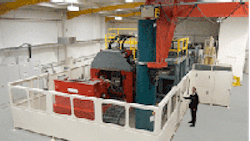World’s largest linear friction welding machine debuts
Moog Inc., East Aurora, N.Y., and Thompson Friction Welding, Clinton Township, Mich., recently teamed up to develop the world’s largest linear friction welding machine. The new machine is capable of welding a surface area of 10,000 mm2, nearly twice as much as previously achieved, and breaks the record of weld forge load at 100 metric tons. Designated the E100, this new machine now extends the use of linear friction welding (LFW) in the automotive and aerospace industries to produce components such as vehicle flooring and secure the blades on jet engines.
The E100 machine and control system represent a major industry breakthrough, as friction-welding technology had never been used before over such a wide operating envelope. Its automatic handling systems and rapid machine open/close features cut production cycle times when compared with traditional manual operations, while recharging of the accumulators takes only around 30 seconds for the largest and longest welds. The E100 now opens up new possibilities for welded fabrication of parts that previously needed to be machined from solid metal, a process that can result in up to 80% material waste. The companies believe that the new machine will transform how jet engines are manufactured by cutting production cycle times and dramatically reducing waste of expensive materials such as titanium.
Thompson manufactured the E100 at their facility in the United Kingdom and found a well-suited development partner in Moog with the requisite expertise in hydraulics, servo system design, control engineering, and manufacturing. Moog’s hydraulic servo system and support for the Thompson E100 included:
• A closed-loop control system delivering fast response at high amplitude with advanced digital control techniques delivering precise control over the weld process. (Traditional servo and proportional valves have a limitation of spool speed and acceleration, which prevents the simultaneous delivery of high amplitude and frequency.) For the E100, Moog valve spools were made to perform three or four times faster than normal. Special precautions were necessary to ensure valve integrity over a large number of welds.
• Multiple digitally-controlled Servovalves, which together operate at peak flow rates of up to 4,500 lpm and possess a high frequency range of 75 to 100 Hz for large scale welding. Multiple valves also improve accuracy when the machine is turned down for smaller, lower force welds.
• Hydraulic power plant delivering over 2 MW of instantaneous power needed to drive the system.
• Seven 400-liter gas volume accumulators each producing massive accumulation to provide the high peak oil flow rate (4,500 lpm) required for the weld.
• Manifold and distribution pipe-work installation; comprehensive sub-system routing oil to multiple active components.
• Experience and expertise in friction welding and project management, design, development, manufacturing, installation and support services.
This is a significant development in light of the unique aspects of linear friction welding. LFW requires more complex machine architecture and control than rotary techniques, but has the advantage that preformed parts of any shape can be joined. Compared to rotary welding, a moving chuck oscillates laterally instead of spinning and the two surfaces are in contact at much higher velocity. This means the two components being welded need to be kept under high pressure at all times.
The benefits of pre-form manufacturing by linear friction welding are numerous. The process, sometimes known as solid-base additive manufacture, allows complex shapes to be manufactured without the wastage of excess material traditionally associated with machining from solid block, casting or forging, saving both manufacturing time and raw material costs. Manufactured parts are close to the final shape so that very little final machining is required to produce a fully functional component. For more information, visit Moog Inc.
